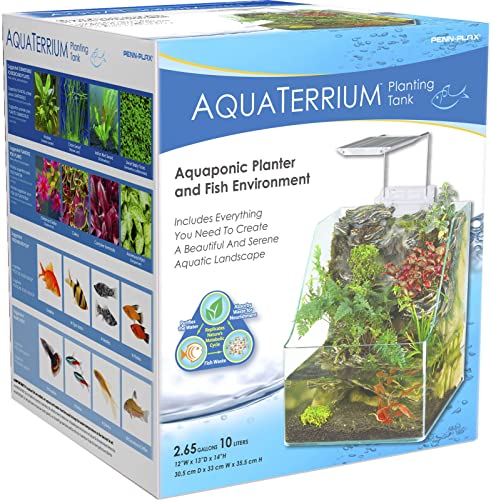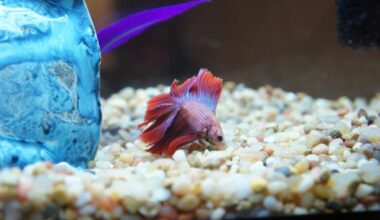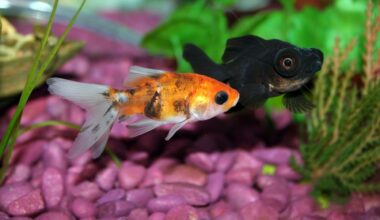Your average person on the street won’t know what a paludarium is. They’ll probably think you made the word up!
But among the aquarist community, paludariums are swiftly building a rabid fan base.
Plenty of traditional aquarium owners have been making the switch or adding a paludarium to their collection.
But why? What makes them so special?
Lucky for you, that’s exactly what we’re going to cover in this info guide. We’ll cove what they are, why people like them, what you can put in them (there are a lot of options), and how you can build a paludarium yourself.
Oh yeah, and we also make some tank and kit recommendations as well.
Let’s get started!
If You’re In A Hurry:
If you just want to know our pick for the best paludarium tank you can buy, here’s a link to check it out.
It’s built great, looks fantastic, and can accommodate a wide variety of setups. We’re huge fans of SeaClear (the manufacturer) and are always impressed with the products they create
Table of Contents
What Is A Paludarium In The First Place?
Paludariums are a growing trend in the tank/aquarium-keeping community. We have been familiar with aquariums, but these are a little bit different. The Latin word “Palus” means marsh or swamp, and “arium” means a place.
This is a semi-aquatic habitat that can house a broad range of terrestrial, aquatic and semi-aquatic plants and animals. What semi-aquatic means is that there is a mixture of land and water habitats in the same tank. This means paludariums can house far more types of species than most of the other typical setups you see.
To better understand exactly what a paludarium is, here are some definitions that explain some different types of tanks:
- Terrariums: A habitat or vivarium for species that solely live on land, meaning they are no water-dwelling creatures inside whatsoever.
- Vivariums: These are any captive spaces in which animals/plants are kept that mimic conditions in nature. Whether a tank is a paludarium, aquarium or terrarium, it is also a vivarium. Over the years it has become common to refer to reptile tanks as vivariums.
- Riparium: An area that is designed to be just like the waterline on the edge of a river, pond, lake, or stream.
One common phrase that people use to describe these unique setups is “a terrarium with fish” which we think is pretty accurate. This is a phrase you might need to use yourself when talking with people outside of this community.
What’s The Appeal?
Paludariums are popular because they have elements from every type of tank combined into one. They allow for more species to be kept in one space because of the diverse habitat, resulting in added viewing pleasure and variety for hobbyists and enthusiasts.

They have a very neat rainforest feel that is fun to observe. Even in a smaller tank, a paludarium gives off the feeling of a very rich ecosystem that many people enjoy.
These types of environments can also be fairly self-maintaining and worth any extra upkeep due to the added variety and range of options they bring. If you compare them to a 100% aquascaping setup, the amount of time and effort required is far lower.
Paludarium Tank And Kit Recommendations
Picking the right paludarium tank is something that a lot of people overthink when they start considering their build.
To help keep things simple, the main factors to consider when looking for the right tank are:
- The number of inhabitants.
- The general layout you want to have.
- If you want a waterfall or not.
- A tank at least 10 gallons in size (you can get away with 5 but only if there aren’t very many critters living inside)
These will serve as the guidelines that will help you decide on the paludarium tank that’s right for you.
If you don’t want to start the shopping process from scratch, here is one of our favorite paludarium tank recommendations to help get you started.
The SeaClear 40 Gallon Acrylic Tank (Our Favorite Paludarium Tank)
There are a number of reasons why we like this tank for a paludarium and recommend it to to so many people.
- Combo includes aquarium, reflector and electrical light fixture
- Acrylic tanks are clearer than glass, 17 times stronger, and only half the weight!
- High clarity and visibility that makes the inhabitants pop
- Lightweight and easy to move around when needed
The products that SeaClear makes are extremely high-quality and durable. We’ve sung their praises in previous buyer guides and keep hearing fantastic feedback from their customers.
The 40 gallon option is great because it allows for a large number of inhabitants and plant life. You also have the room to construct a waterfall if you choose to do so.
If this tank is a little on the large size, they also have some smaller options in their acrylic tank line that should fit what you’re looking for.
The Best Kit Option
While this isn’t something we personally have experience with, there are paludarium kits that come equipped with a lot of the basics to save you some build time.
- Features a crystal clear glass tank, aquaponic waterfall, rockscape with planting pods, filter, and deluxe artificial plant pack.
- Pump circulates water through cascading waterfall providing nutrients to plants through hydroponics
- High powered LED plant growth light helps live plant thrive in the ecosystem
- Terrarium tank measures 12” x 13” x 14” high
Typically this means plant life and the layout is taken care of, and it’s on you to add whatever animals you wish.
We think that the building process is part of the fun, so we recommend that instead if you can find the time. It will also make you more knowledgable about the life in your paludarium and how to take care of them.
Ideas For Animals To Include
Due to its semi-aquatic environment, paludariums can home a much larger array of plants and animals than a regular aquarium or terrarium. Here is a list of potential species that may be used to enhance the atmosphere and ecosystem in your tank, starting with the aquatic portion:
Freshwater Fish
Popular fish choices include assorted killifish, cichlids, angelfish, mollies, danios, gouramis, common mollies, guppies, and others. Some paludarium owners choose only a couple of these species to achieve a “tidier” look, while others like the appearance of many different types of fish in their ecosystem.
Just be sure to consider, when selecting species, that each fish should have similar requirements for water conditions (hardness, temperature, pH) should they be in the same water.
Shrimp
Species such as Cherry, ghost or Amano shrimp can enhance the appearance of the paludarium while providing a natural cleaning crew. Shrimp will graze and eat plant matter and debris floating in the water while producing little waste.
Snails/Other
Freshwater snails can provide some subtle variety should a few different species other than fish be desired in the water. Popular choices include Nerite or Mystery snails. Springtails and fiddler crabs are also a different option, and they will keep your tank cleaner as well.
Semi-aquatic animal options consist of:
- Turtles: Painted sliders do the best in this environment.
- Frogs And Toads: Green frogs are a common choice at all stages of development. Dart frogs can be another great choice.
- Salamanders: The American Tiger Salamander is a common choice, with a carnivorous diet of small fish, earthworms and other meaty foods.
- Newts: Newts are active animals that switch frequently between land and water, making them interesting to view in a tank. Popular species include the Pacific and Fire-bellied newts. Much like salamanders, their diet consists of small fish, meaty foods and pellet diets.
- Mudskippers: These funky little critters are extremely entertaining and will thrive in this kind of environment.
- Water dragons: This is great reptile choice that can do very well and looks right at home.
Note: Many tank keepers enjoy introducing tadpoles into their tank. This allows them to grow and go through their stages of metamorphosis (making their way from water to land), which can be an exciting process to watch.
Terrestrial species such as snakes and lizards can utilize the land portion of the paludarium, given that they can coexist with the other aquatic and semi-aquatic species.
The most important thing to remember when placing animals and plants in your tank is conflicts between species. It’s possible for some plants to be toxic if ingested by some species.
Also, some animals may not get along with others. Be aware of these relationships when creating the habitat in your tank to avoid unwanted casualties. Another important step is that every paludarium’s water, just like a regular aquarium, must be cycled before animals are placed.
Ideas For Plants To Include
There are a large variety of terrestrial, aquatic and semi-aquatic plants to choose from when selecting species for a paludarium. Some tank keepers prefer form, while others function.
For example, some people prefer paludarium plants that grow slower to reduce the need for pruning and maintenance. Here is a broad list of different plants to choose from that can thrive in a tank environment:
- Floating plants can thrive in the aquatic portion of a paludarium. Java moss, for example, can be a low maintenance species that thrives in water and can improve the health of other species residing with it. Floating plants are a good choice for shy and nocturnal fish, who need hiding places during the day. Salvinia, a floating fern, is a popular choice as well.
- Ferns, such as button, Boston or lemon ferns grow quickly and can provide dense brush.
- Viny plants, such as creeping fig or Devil’s Ivy can cover the walls of a paludarium and create a natural “curtain” or backdrop, should that be the desired effect. Eventually, their stems can take root in water and provide shelter for aquatic animals, making them a good semi-aquatic option.
- Bromeliads, a hardy variety of flowering plants that can add significant color in a tank for aesthetics.
- Carnivorous plants such as Butterworts or bladderworts are an exciting choice that feed off of insects/small water creatures and are interesting to watch. Use caution, however, because they may feed off of small species in the tank that are not intended for use as food.
- Any aquatic plants. Anubias and cryptocoryne are commonly found in paludariums.
- Orchids can be pretty, but they tend to be harder to care for. They need to be planted on the terrestrial side of the tank, away from the water, because they have a limited tolerance for humidity.
- Flowering plants such as crotons, peace lilies, and dracaena – the deciding factor is which plants have the desired look. There are extensive options.
- Lucky bamboo can grow in soil or water and is popular for its appearance.
- Pothos plants are another choice that can add a neat look and feel to the tank.
Additional Options
If space isn’t an issue, some tank keepers house semi-aquatic dwarfed trees and mangroves. People have also gone as far as growing herbs, veggies, and fruit in their paludariums! It all depends on the plant’s tolerance for water.
The choice is yours!
The Building & Setup Process
The easiest way to set up your paludarium, especially if you’re a beginner, is to do it in stages.
Most beginning tank keepers start small, with about five gallons, and work their way up when they feel more comfortable. Most people use a regular glass aquarium for optimal viewing.
Whatever materials are used MUST be aquarium-safe. Here are some steps to follow that will make construction easier:
1. Initial Planning
Map out where the land area and water portions of your paludarium will be. It makes sense to add the terrain first, and the water last. One of the most important elements needed for a healthy tank is a watertight seal between the land and water. Preventing flooding will help the terrestrial and semi-aquatic species placed in later to thrive.
Plexiglass is a common material used for the divider, but any watertight and aquarium-safe material will do. Silicone can be used for sealing to ensure no leaking. Once these two areas are laid out, you can start to build your land portion.
2. Construct The Land Portion
The land portion can be constructed out of many different materials : wood, sand, rocks. You can even use upside-down bowls/pots to create raises in the terrain. The key is to remember what will be hard to remove for cleaning, and what will trap debris.
Foam sealant can help hold things together and can be carved into the desired shape. The land portion MUST have a drain in the bottom to prevent flooding if the water level gets too high.
3. Substrate And Plants
Now is the time to add the soil/other substrates and plants. Bear in mind which plant species can tolerate close proximity to the water portion. The top layer of the paludarium (the canopy) can be added as well. This can consist of rocks, hanging plants, branches – shelter for the terrestrial animals.
4. Setting Up The Water Area
The last step is to add the water portion. This will help maintain humidity and should have all the elements of a regular aquarium (correct water conditions, filtration, etc.). Some people rely solely on plants for water filtration, while others use small filters that are able to be submerged. The water MUST be cycled before adding animals to it.
5. An In-Between Area
It’s a good idea to have places where the terrestrial animals can be around the water without having to be fully in. This can be achieved with a floating shelf. Common materials for this are cork, driftwood, or PVC.
Moss can be grown on the floating shelf as added food/substrate for the animals in the tank. Peat can also be added in shallow water portions to create a bog-like environment for semi-aquatic plants.
6. Optional Waterfall Setup
An additional feature commonly found in paludariums is waterfalls. This is not crucial but can have a beautiful effect on the overall appearance of the tank. This can be made with a filter to move the water, and an elevated surface for the water to flow down such as wood or rocks.
After adequate cycling of the water portion, everything is finally ready for its new inhabitants and animals can be added at this time.
7. Have Fun!
Now that all the hard work has been taken care of, it’s time to enjoy watching your little ecosystem come to life!
Get Building!
Paludariums are a unique and rewarding pursuit if you’re interested in trying something new. The variety and distinct atmosphere that they can add to a room are really unlike anything else.
A lot of new owners assume that putting one together is challenging (since they’re used to 100% aquatic environments), but it really isn’t.
Just stick to the basics and be mindful of what each of the living things in your tank needs to thrive and you’ll be just fine.
The paludarium community is growing quickly, and we can’t wait to see the unique setups and innovation that will inevitably come in the near future.
If you have a build or setup that you want to share, we would love to see it. We might even want to share it on our site!




